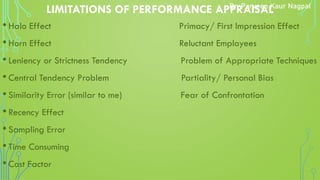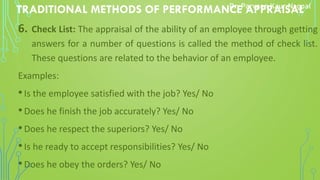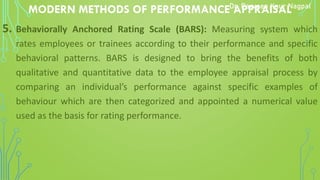4. Performance Appraisal
- 2. Dr. Parveen Kaur NagpalPERFORMANCE APPRAISAL Performance appraisal is a systematic and objective way of evaluating the relative worth or ability of an employee in performing the job. Performance appraisal is the review of an individual’s performance in an orderly way, the performance is measured by considering factors like job knowledge, quality and quantity of output, initiative, leadership abilities, supervision, dependability, co-operation, judgment etc. Thus performance appraisal is a process of assessing an employees job relevant strengths and weaknesses. According to Flippo, “Performance appraisal is the systematic, periodic and an impartial rating of an employee’s excellence in the matters pertaining to his present job and his potential for a better job.”
- 3. Dr. Parveen Kaur NagpalPERFORMANCE APPRAISAL •Appraisal should be in writing and carried at least once a year. •It should be shared with the employee. •Employees should have a mechanism to appeal the results of the performance appraisal. •Evaluator should be trained to carry out the appraisal process •It should focus on employee behaviour and results rather than on personal traits.
- 4. Dr. Parveen Kaur NagpalPURPOSE/ BENEFITS OF PERFORMANCE APPRAISAL •Employee pay/ salary decision. •Improving the quality of an employee in job performance. •Minimizes the communication gap between the employer and employee. •Promotion and Transfer decisions •Identify training needs •Discharging/ Lay off decisions •Minimize as well as address employee grievances •Ensures job satisfaction and increase morale •Documentation (Evidence) •Timely Review and Feedback for self development
- 5. Dr. Parveen Kaur Nagpal LIMITATIONS OF PERFORMANCE APPRAISAL •Halo Effect Primacy/ First Impression Effect •Horn Effect Reluctant Employees •Leniency or Strictness Tendency Problem of Appropriate Techniques •Central Tendency Problem Partiality/ Personal Bias •Similarity Error (similar to me) Fear of Confrontation •Recency Effect •Sampling Error •Time Consuming •Cost Factor
- 6. Dr. Parveen Kaur Nagpal METHODS/ TECHNIQUES OF PERFORMANCE APPRAISAL Traditional Methods Confidential Report Narrative Essay Ranking Method Paired Comparison Grading Method Check List Rating Scale Forced Choice Method Critical Incident Method Modern Methods Management by Objectives (MBO) Behaviorally Anchored Rating Scale (BARS) Assessment Centers 360 Degree Appraisal Human Resource Accounting
- 7. Dr. Parveen Kaur Nagpal TRADITIONAL METHODS OF PERFORMANCE APPRAISAL 1. Confidential Report: The rater prepares a report on employees strengths and weaknesses and record ratings w.r.t employees attendance, technical ability, team work etc. 2. Narrative Essay: The manager describes employees performance over the entire evaluation period by writing a narrative detailing the strength and weaknesses 3. Ranking Method: An employee is ranked against the other in the working group under this method. Each employee be compared with the other person This can be useful in small organization.
- 8. Dr. Parveen Kaur Nagpal TRADITIONAL METHODS OF PERFORMANCE APPRAISAL 4. Paired Comparison Method: Each employee is compared with other employees considering only one at a time. The evaluator compares two employees and puts a tick mark against an employee whom he considers better. It is suitable for big organizations.
- 9. Dr. Parveen Kaur Nagpal TRADITIONAL METHODS OF PERFORMANCE APPRAISAL 5. Grading Method: Certain categories of abilities or performance of employees are defined well in advance to fall in certain grades under this method. Such grades may be O, A, B, C, D (Outstanding, Good, Average, Poor and Very poor). Here the individual traits and characteristics are identified.
- 10. Dr. Parveen Kaur Nagpal TRADITIONAL METHODS OF PERFORMANCE APPRAISAL 6. Check List: The appraisal of the ability of an employee through getting answers for a number of questions is called the method of check list. These questions are related to the behavior of an employee. Examples: •Is the employee satisfied with the job? Yes/ No •Does he finish the job accurately? Yes/ No •Does he respect the superiors? Yes/ No •Is he ready to accept responsibilities? Yes/ No •Does he obey the orders? Yes/ No
- 11. Dr. Parveen Kaur Nagpal TRADITIONAL METHODS OF PERFORMANCE APPRAISAL 7. Graphic Rating Scale: It is also known as linear rating scale. In this method, the printed appraisal form is used to appraise each employee. It lists traits and a range of job performance characteristics for each trait. The rating is done on the basis of five points on the continuum.
- 12. Dr. Parveen Kaur Nagpal TRADITIONAL METHODS OF PERFORMANCE APPRAISAL 8. Forced Choice Method: A method which forces the rater to distribute the ratings of the overall performance of an employee is known as forced distribution method. This method is suitable to large organizations, but the individual traits cannot be appraised. Group wise rating is done.
- 13. Dr. Parveen Kaur Nagpal TRADITIONAL METHODS OF PERFORMANCE APPRAISAL 9. Critical Incident Method: The performance appraisal of an employee is done on the basis of the incidents occurred really to the concerned employee.
- 14. Dr. Parveen Kaur Nagpal MODERN METHODS OF PERFORMANCE APPRAISAL 1. Management by Objectives (MBO): Performance is rated against the achievement of objectives stated by the management. It is useful for managerial positions and not applicable to all jobs 2. 360-degree Feedback: It is a systematic collection of performance data on an individual group, derived from a number of stakeholders like immediate supervisor, team members, customers, peers and self.
- 15. Dr. Parveen Kaur Nagpal MODERN METHODS OF PERFORMANCE APPRAISAL 3. Assessment Centers: Involve the use of methods like social/informal events, tests and exercises, assignments being given to a group of employees to assess their competencies to take higher responsibilities in the future. Trained evaluators observe and evaluate employees as they perform the assigned jobs and are evaluated on job related characteristics. 4. Human Resource Accounting Method: It tries to find the relative worth of human assets in terms of money. Performance appraisal of the employees is judged in terms of cost and contribution of the employees. Cost include all the expenses incurred on them like their compensation, recruitment and selection costs, induction and training costs etc. whereas their contribution includes the total value added (in monetary terms).
- 16. Dr. Parveen Kaur Nagpal MODERN METHODS OF PERFORMANCE APPRAISAL 5. Behaviorally Anchored Rating Scale (BARS): Measuring system which rates employees or trainees according to their performance and specific behavioral patterns. BARS is designed to bring the benefits of both qualitative and quantitative data to the employee appraisal process by comparing an individual’s performance against specific examples of behaviour which are then categorized and appointed a numerical value used as the basis for rating performance.
- 17. Dr. Parveen Kaur Nagpal
- 18. Dr. Parveen Kaur Nagpal PROCESS OF PERFORMANCE APPRAISAL Establishing Performance Standards Communicating The Standards Measuring the Actual Standards Comparing Performance with the Standards Discussing Results/ Post Appraisal Interview Corrective Measures Review
- 19. Dr. Parveen Kaur Nagpal GUIDELINES FOR CONDUCTING PERFORMANCE INTERVIEWS • Proper Planning • Efficient Evaluators • Mutual Trust • Clear Objectives • Analysis of Strength and Weaknesses • Proper Timing • Timely Feedback • Standardization • Trained Evaluators • Review and Appeal • Individual Differences
- 20. Dr. Parveen Kaur Nagpal ETHICAL ASPECTS IN PERFORMANCE APPRAISAL I. Ethics on the Part of Appraiser / Rater •Adequate Information •Reliability •Objective Evaluation •Uniform Evaluation Criteria •Laws and Regulations of Performance Appraisals •Timely and Proper Feedback •Communication •Transparency
- 21. Dr. Parveen Kaur Nagpal ETHICAL ASPECTS IN PERFORMANCE APPRAISAL II. Ethics on the Part of Appraisee •Correct Information: The appraisee must provide correct and adequate information to the appraiser for proper conduct of performance appraisal. •Avoid Confrontation: The ratee may avoid confrontation or be defensive if he/ she receives unfavorable remarks from the rater. •Attitude Towards Ratings: The employee should have positive attitude towards the rating system.
- 22. Dr. Parveen Kaur Nagpal CASE STUDY - PERFORMANCE APPRAISAL Mr. Abeer Mehra is a talented and well experienced Human Resource Manager of Trinity Company. He is an administrative expert and a change agent, always an inspiration for his subordinates and the employees whose performance is measured and appraised by him. It is because of his 10 years of experience of working in HR department that he got acquainted with various performance appraisal methods. However, he mainly rated his employees in a fair manner using graphic rating scale. He commanded lot of respect and faith from his employees due to his appropriate and fair performance appraisal techniques.
- 23. Dr. Parveen Kaur Nagpal CASE STUDY - PERFORMANCE APPRAISAL However recently, he developed good rapport with Mr. Rohan Sehgal and Mr. Ram Kapoor, who belonged to his native place. He suddenly started appraising Rohan and Ram leniently. He promoted them unethically and the other employees realized it. Some senior employees resigned as a result of this. Questions: 1. Analyze the case 2. What according to you should be the appropriate appraisal methods used in organizations? 3. Discuss the ethical issues in performance appraisal w.r.t this case.
- 24. Dr. Parveen Kaur Nagpal CASE STUDY - PERFORMANCE APPRAISAL M/S Modern Department stores is having a chain of stores in leading cities with its HQ at Bangalore. In Bangalore the store has 150 employees. This firm follows graphic rating scale for performance evaluation. Annual performance rating is the basis of increment, promotion, selection for training and posting to attractive positions. A number of representations were received by the MD in regard to the subjectivity of the present assessment system. MD interviewed 10 persons and all of them complained that they were denied increment because of lesser rating where as many others who are less qualified and less experienced got the increment because of better rating.
- 25. Dr. Parveen Kaur Nagpal CASE STUDY - PERFORMANCE APPRAISAL On further survey it is found that nearly one third of employees are unhappy with the present rating system. At present there is no union activities but there are strong rumours that the employees are thinking of forming a union. Questions: 1. What are the problems you find in the present rating system of the company? Put up your suggestions for improvement. 2. Can you propose a better alternate performance evaluation system?
- 26. Dr. Parveen Kaur Nagpal CASE STUDY - PERFORMANCE APPRAISAL Mr. Pinto of Yummy Ice-creams terminated Mr. D’mello, aged 46, from the services. Mr Pinto argued that termination was based on his low performance. However Mr. D’mello approached the Grievance Redressal Cell and finally the court. The court asked Mr. Pinto to provide copies of Mr. D’mello’s poor performance rating to justify the termination grounds. However in reality there was no appraisal conducted at all. Explain the advantages of conducting performance appraisal and maintaining appropriate records
- 27. Dr. Parveen Kaur Nagpal REFERENCES 1. Aswathappa, K., Human Resource Management: Text and cases. Delhi: Tata McGraw-. Hill Publishing Company Limited, 2008 2. Gary Dessler, “A Framework for Human Resource Management”, Pearson 3. Nagpal, Human Resource Management, M. Com Part II, Sem 3, Sheth Publishers
- 28. Thank You Dr. Parveen Nagpal www.linkedin.com/in/dr-parveen-kaur-nagpal-82965b15




























